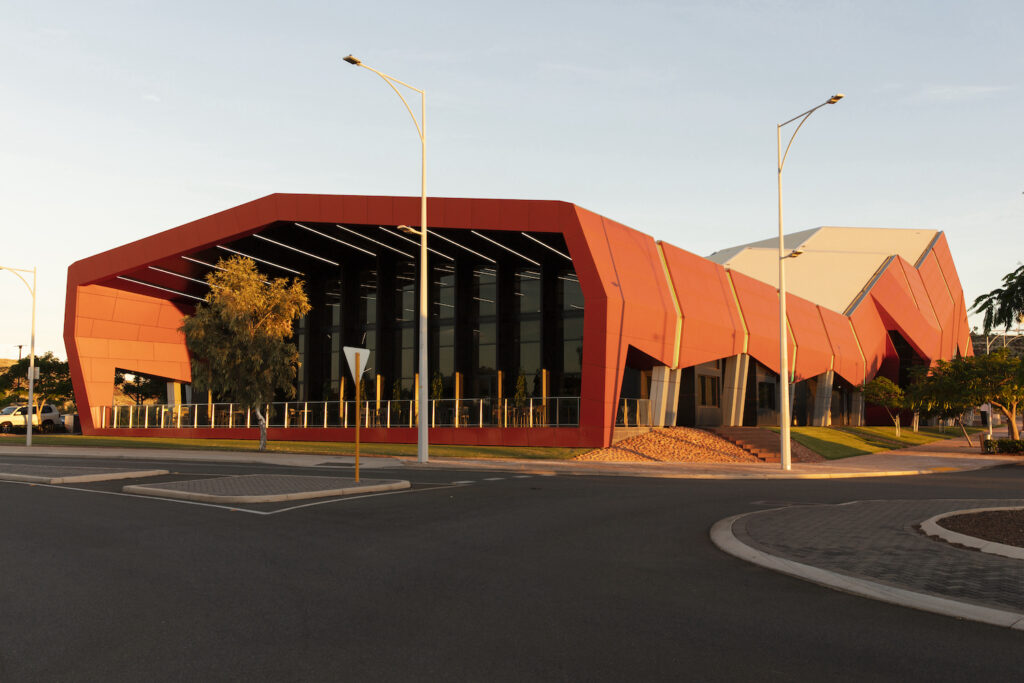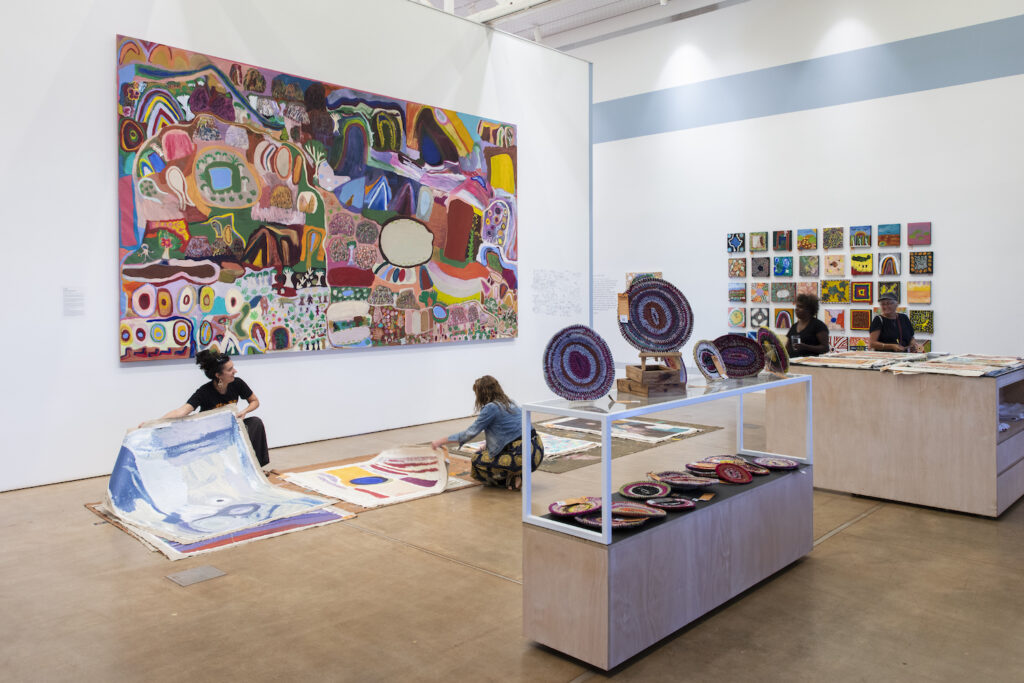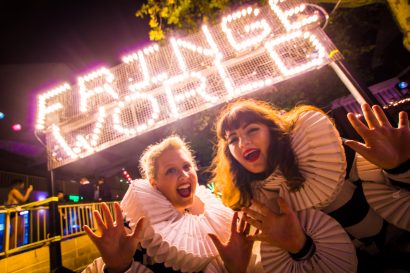There’s plenty of opportunity to immerse yourself in First Nations art and more, in the Pilbara, says Ara Jansen. You might just have to drive further to discover it.
Plunge into the art of the Pilbara
29 June 2023
- Reading time • 10 minutesMulti-arts
More like this
- Halloween special: How to make blood and other stage tricks
- Seadragon weaves magic spell
- Spring into the school holidays
In the fourth instalment of Seesaw Magazine’s series showcasing the arts in regional Western Australia, we head north into the Pilbara.
Travelling into the north west often brings with it plans for active adventures – swimming in waterholes, fishing, hiking or rugged terrain driving. What if you’re more interested in an arty adventure?
While it may not be the first thing you think of, the Pilbara is a busy region for the arts, especially if you’re interested in Aboriginal art. Peppered around Roebourne, Karratha and Onslow, you’ll find a variety of galleries, spaces and centres which are dedicated to giving voice to local regional artists.
It’s worth stopping in at the visitor centres in bigger towns for the gems. The locals might have a few hidden places to reveal when asked. There’s certainly plenty of choice, depending on which towns or communities you want to visit.
In this part of the State, check ahead about opening times as these can be seasonal, by appointment or dependent on any extreme weather.
By no means an exhaustive list of what’s on offer, here are some ideas of where to start to plan your itinerary.
Roebourne
Yinjaa-Barni Art

Yinjaa-barni is Yindjibarndi for staying together. A collective of First Nations artists who predominantly belong to the Yindjibarndi language group, their ancestral homelands surround the Fortescue River and Millstream Tablelands.
These artists create deeply personal works of collective memory, rendering the wildflowers, river systems and landforms of their country onto canvas. The artists have exhibited nationally and internationally and won numerous awards. For them, art is an important means of expressing and relaying love for Country, culture and regional flora.
Yinjaa-Barni Art began painting together at Roebourne’s Pilbara Aboriginal Church in 2004, before moving to the heritage-listed Dalgety House on the banks of the Harding River in 2007. A peaceful space where artists paint together, Yinjaa-Barni is home to cross-generational talent. Yindjibarndi elders and senior artists Maudie Jerrold and the late Mr Mack (1952 – 2019) were part of the inception of the region’s Aboriginal art movement and embody important cultural knowledge in their artwork.
Yinjaa-Barni Art is open 9am – 1.30pm weekdays and by appointment after these hours.
Wangaba Roebourne Art Group / Ngarluma Art Group
The Ngarluma Art Group represents a number of local Aboriginal artists. They have regular exhibitions and host art activities. You can buy their work online or visit in person. Check the website for opening hours and examples of work for sale.
Karratha
Red Earth Arts Precinct

Built in 2018, the Red Earth Arts Precinct is a state-of-the-art performance and art centre in Karratha. Not only is it an architecturally interesting building, it’s home to latest big screen block busters, the library and local history archives, if you want some family history help. The walls display works from the City of Karratha’s impressive art collection, including acquisitions from the annual Cossack Art Awards.
The venue hosts exhibitions like the Wangaba Roebourne Art Group’s First Design, which celebrates First Nation’s art and design with looks from the runways of New York and Melbourne Fashion weeks. The exhibition runs to 25 August 2023.
Don’t buy it – make it
Want to make art rather than look at it? Why not try the Pilbara Paint + Sip. There are public classes at the Karratha Country Club and the Hula Bar.
Newman
Martumili Artists

Martumili is the home of western desert artists – a vibrant hub for Martu artists from six remote desert communities scattered across the Western, Great Sandy, Sandy and Gibson deserts. Based in the East Pilbara Arts Centre, these artists came together to paint Country and culture, saying that it makes them pukurlpa – happy inside.
As the senior artists paint their Country they remember their pujiman (bush) days when they lived in the desert, they want to share their experiences with their young people.
With more than 500 artists on their books, Martumili is one of the youngest, yet largest art centres in Australia.
Martumili’s home is a large, open shed that provides studios, workspaces, library, offices, archives and framing areas. In the middle is the Martumili gallery that showcases exhibitions, which often travel the nation.
Onslow
Shells galore

The Neil Baker Shell Collection in Onslow is one of the largest in Australia.
Collected over the last 70 years by fisherman and boat builder Neil Baker, the shells come from all over Australia and the Indian Ocean.
Collecting seashells began as a childhood fascination for Baker and grew over time to become a vast collection of more than 5,000 shells.
The collection tells the story of the extraordinary diversity of our favourite beach molluscs. Baker collected most of them on the reefs around Onslow and the Montebello islands.
The Neil Baker Shell Collection is open April – October.
Warmun
Warmun Arts Centre

One of the early engine rooms for the contemporary Aboriginal art movement, Warmun Art Centre was founded by leading Gija artists such as Rover Thomas, Queenie McKenzie and Jack Britton. Today, ochres of black, red and mustard yellow, mixed with greys and whites are the hallmarks of the distinctive Warmun community artist style.
As you enter the community to arrive at the art centre, paintings feature on every available sign and building, announcing the importance of art in this community. The Gija artists have preserved one of Australia’s most significant community collections for their families, featuring the works of their founding elders, now passed.
An exhibition space in the centre of the gallery displays the artefacts of Gija culture, with recordings by elders about their history, culture and art. The centre runs artist workshops and studios plus programs with children and young artists, the results of which are featured in the showroom.
Cossack
Cossack Museum

Located on the banks of the Harding River, the Cossack Museum is housed in the old courthouse, now resurrected from the abandoned port town of Cossack.
As Perth was developing into the state’s capital, settlers sought out new lands and industries in the uncharted northern district. Cossack became its first northern port, servicing the town of Roebourne and the growing pearling fleet. Built in 1895 by the esteemed government architect George Temple Poole, it’s now part of a complex that includes a café, gallery, guesthouse and exhibition space that hosts regular art markets and music events. The surrounding gardens are littered with evocative remnants of the past – tanks, engines and other paraphernalia that continue to be unearthed.
Want more ideas?
Check out the WA Museum’s WAnderland website.
Note: when buying Aboriginal art, consider whether the group is part of the voluntary industry code – The Indigenous Art Code. It’s a set of rules and guidelines that dealers (both First Nations and non-First Nations businesses) commit to follow to ensure ethical practices and fair treatment of artists. Their website will often have the logo on it.
Pictured top: Yinjaa-barni artist Melissa Sandy. Photo: Bobbie Lockyer
Like what you're reading? Support Seesaw.







